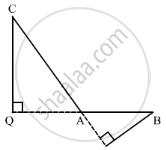Advertisements
Advertisements
प्रश्न
In ∆ABC, ∠A is obtuse, PB ⊥ AC and QC ⊥ AB. Prove that:
(i) AB ✕ AQ = AC ✕ AP
(ii) BC2 = (AC ✕ CP + AB ✕ BQ)
उत्तर
Given: ΔABC where ∠BAC is obtuse. PB ⊥AC and QC⊥AB.

To prove:
(i) AB × AQ = AC × AP and
(ii) BC2 = AC × CP + AB × BQ
Proof: In ΔACQ and ΔABP,
∠CAQ = ∠BAP (Vertically opposite angles)
∠Q = ∠P (= 90°)
∴ ΔACQ ∼ ΔABP [AA similarity test]
`rArr"CQ"/"BP"="AC"/"AB"="AQ"/"AP"` [Corresponding sides are in the same proportion]
`"AC"/"AB"="AQ"/"AP"`
⇒ AQ x AB = AC x AP .....(1)

In right ΔBCQ,
⇒ BC2 = CQ2 + QB2
⇒ BC2 = CQ2 + (QA + AB)2
⇒ BC2 = CQ2 + QA2 + AB2 + 2QA × AB
⇒ BC2 = AC2 + AB2 + QA × AB + QA × AB [In right ΔACQ, CQ2 + QA2 = AC2]
⇒ BC2 = AC2 + AB2 + QA × AB + AC × AP (Using (1))
⇒ BC2 = AC (AC + AP) + AB (AB + QA)
⇒ BC2 = AC × CP + AB × BQ
APPEARS IN
संबंधित प्रश्न
Two poles of height 9 m and 14 m stand on a plane ground. If the distance between their feet is 12 m, find the distance between their tops.
Using Pythagoras theorem determine the length of AD in terms of b and c shown in Figure.
In a ΔABC, AB = BC = CA = 2a and AD ⊥ BC. Prove that
(i) AD = a`sqrt3`
(ii) Area (ΔABC) = `sqrt3` a2
∆ABD is a right triangle right-angled at A and AC ⊥ BD. Show that
(i) AB2 = BC x BD
(ii) AC2 = BC x DC
(iii) AD2 = BD x CD
(iv) `"AB"^2/"AC"^2="BD"/"DC"`
If D, E, F are the respectively the midpoints of sides BC, CA and AB of ΔABC. Find the ratio of the areas of ΔDEF and ΔABC.
The co-ordinates of the points A, B and C are (6, 3), (−3, 5) and (4, −2) respectively. P(x, y) is any point in the plane. Show that \[\frac{ar\left( ∆ PBC \right)}{ar\left( ∆ ABC \right)} = \left| \frac{x + y - 2}{7} \right|\]
Find the side and perimeter of a square whose diagonal is `13sqrt2` cm.
Find the height of an equilateral triangle having side 4 cm?
Find the altitude of an equilateral triangle of side 8 cm.
In a ΔABC, ∠CAB is an obtuse angle. P is the circumcentre of ∆ABC. Prove that ∠CAB – ∠PBC = 90°.
